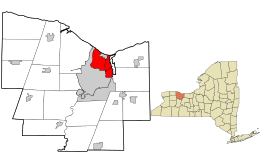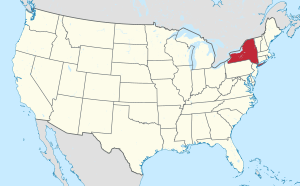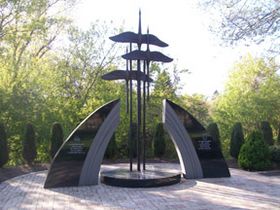Irondequoit, New York facts for kids
Quick facts for kids
Irondequoit
|
|
|---|---|

Location in Monroe County and the state of New York.
|
|

Location of New York in the United States
|
|
| Country | United States |
| State | New York |
| County | Monroe |
| Founded | March 27, 1839 |
| Area | |
| • Total | 16.82 sq mi (43.57 km2) |
| • Land | 14.99 sq mi (38.82 km2) |
| • Water | 1.83 sq mi (4.75 km2) |
| Elevation | 368 ft (112 m) |
| Population
(2020)
|
|
| • Total | 51,043 |
| • Estimate
(2021)
|
50,548 |
| • Density | 3,372.65/sq mi (1,302.15/km2) |
| Time zone | UTC-5 (EST) |
| • Summer (DST) | UTC-4 (EDT) |
| ZIP code |
14609, 14617, 14621, 14622
|
| Area code(s) | 585 |
| FIPS code | 36-055-37726 |
| Website | http://www.irondequoit.org/ |
Irondequoit is a town in Monroe County, New York, United States. In 2020, about 51,043 people lived there. Irondequoit is a suburb of the city of Rochester. It is located just north and east of Rochester. The name "Irondequoit" comes from the Iroquois language and means "where the land meets the water."
Contents
History
Early Days
In 1687, a French leader named Marquis de Denonville led an army of French soldiers and Huron warriors. They went on a journey through Irondequoit Bay to fight against the Iroquois people. This event started a long period of bad feelings between the Iroquois and the French.
After the American Revolution, this area became part of something called the Phelps and Gorham Purchase. The Town of Irondequoit was officially started in 1839. It was formed when it separated from the Town of Brighton.
Growing Up
In the late 1800s, the northern part of Irondequoit became a popular place for tourists and people on vacation. People from the City of Rochester would visit. It was even known as the "Coney Island of Western New York" because it was a fun place to go.
After World War II, many soldiers came home and needed places to live. Irondequoit grew a lot during this time. It was the first suburb in Monroe County where many people moved from Rochester. The population jumped from 23,376 in 1940 to 55,337 in 1960. That's a huge 136% increase! Irondequoit was the most populated suburb in Monroe County until the 1970s. Then, the Town of Greece, which is much larger, became more populated.
A Special Program
In 1965, Irondequoit made history in civil rights. It was part of the first completely voluntary program to bring different groups of students together in schools. This program is called the Urban Suburban Interdistrict Transfer Program. It still works today!
It started with 25 first graders from Rochester's inner city. They began their school journey in the West Irondequoit school district. Many of these students, 15 of them, graduated together in 1977. They were the first group to go through all 12 years of this special program. The White House even sent a letter, and it was noted in the U.S. Congressional Record. This program has grown and now includes more school districts around Rochester.
Sister City
In 1991, Irondequoit started a "sister city" relationship with Poltava, a city in Ukraine. A sister city relationship means two cities in different countries become partners to promote cultural ties and understanding. Poltava is a city in Eastern Ukraine. This idea was led by Irondequoit Town Supervisor Fred Lapple. It was also strongly supported by the Ukrainian community living in Irondequoit.
Where is Irondequoit?
Land and Water
Irondequoit covers about 16.8 square miles (43.57 square kilometers). Most of this area, about 15.2 square miles (38.82 square kilometers), is land. The rest, about 1.6 square miles (4.75 square kilometers), is water.
The town is located between the Genesee River on its west side and Irondequoit Bay on its east side. The northern edge of the town is along the shore of Lake Ontario. Because water surrounds it on three sides, it's like a "headland" or a piece of land that sticks out into the water.
Neighboring Areas
Irondequoit shares borders with the city of Rochester to its west and south. To the southeast, it borders the town of Brighton. To the east, it borders the towns of Webster and Penfield.
Special Borders
There's an interesting border between Irondequoit and Rochester. On Irondequoit's western side, the city of Rochester claims a narrow strip of land. This strip runs along the Genesee River all the way to Lake Ontario. In some spots, it's less than 50 yards (46 meters) wide. This means that Rochester claims the entire eastern shore of the Genesee River, and Irondequoit's border never quite touches the river.
Also, the northern part of Durand-Eastman Park (including Durand Beach) is actually inside Rochester's city limits. The same goes for a narrow strip along Culver Road. This can be confusing for people, even those who have lived there a long time! For example, many wonder if places like Seneca Park or Durand Park are in Irondequoit or Rochester. Seneca Park became part of Rochester in 1891, and Durand Eastman Park was given to the city in 1908.
Who Lives in Irondequoit?
| Historical population | |||
|---|---|---|---|
| Census | Pop. | %± | |
| 1840 | 1,252 | — | |
| 1850 | 2,397 | 91.5% | |
| 1860 | 3,547 | 48.0% | |
| 1870 | 3,990 | 12.5% | |
| 1880 | 1,986 | −50.2% | |
| 1890 | 2,415 | 21.6% | |
| 1900 | 2,863 | 18.6% | |
| 1910 | 3,526 | 23.2% | |
| 1920 | 5,123 | 45.3% | |
| 1930 | 18,024 | 251.8% | |
| 1940 | 23,376 | 29.7% | |
| 1950 | 34,417 | 47.2% | |
| 1960 | 55,337 | 60.8% | |
| 1970 | 64,897 | 17.3% | |
| 1980 | 57,648 | −11.2% | |
| 1990 | 52,377 | −9.1% | |
| 2000 | 52,354 | 0.0% | |
| 2010 | 51,692 | −1.3% | |
| 2020 | 51,043 | −1.3% | |
| 2021 (est.) | 50,548 | −2.2% | |
| U.S. Decennial Census | |||
Population Growth
In 2000, there were 52,354 people living in Irondequoit. There were 22,247 households, which are groups of people living in one home. About 26.7% of these households had children under 18. Also, 50.7% were married couples living together.
The average number of people in a household was 2.32. The average number of people in a family was 2.91.
The population in Irondequoit is made up of people of all ages. About 21.9% were under 18 years old. About 22.5% were 65 years or older. The average age in the town was 43 years old.
Famous People from Irondequoit
The following people are well-known and either grew up in Irondequoit or lived there for a long time:
- Richard Brookhiser - He is a historian who writes about important figures in American history. He graduated from Irondequoit High School in 1973.
- Cito Culver - He was a top draft pick for the New York Yankees baseball team.
- Steve Gadd - He is a famous drummer who has played with many well-known musicians like Paul Simon and Eric Clapton.
- Tom Golisano - He started the company Paychex. He also ran for governor of New York State three times. He graduated from Irondequoit High School. From 2003 to 2011, he owned the Buffalo Sabres hockey team.
- Kent Syverud - He is the 12th Chancellor and President of Syracuse University.
Learning in Irondequoit
Irondequoit has two main public school districts: the West Irondequoit and East Irondequoit central school districts.
There are also several schools with religious connections:
- Archangel School (Roman Catholic)
- Bay Knoll School (Seventh-day Adventists)
- Derech Hatorah (for Jewish education)
- Bishop Kearney High School (connected with the Diocese of Rochester)
- Two schools run by the Roman Catholic Diocese of Rochester:
- Saint Kateri School
- Saint Ambrose Academy
Irondequoit is also home to smaller campuses of two colleges:
- Empire State College's Genesee Valley Learning Center
- Everest Institute's Rochester campus
See also
 In Spanish: Irondequoit para niños
In Spanish: Irondequoit para niños


